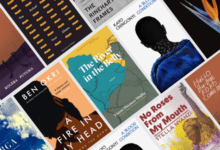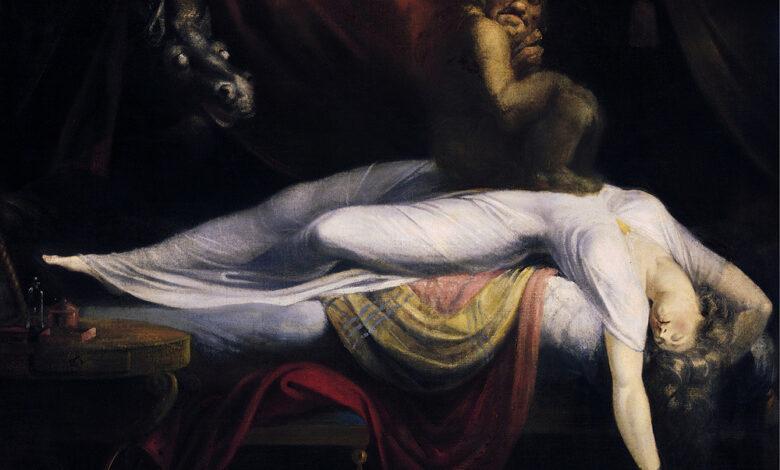
Top 15 Forbidden Paintings in the World
Top 15 Forbidden Paintings in the World – Throughout history, art has pushed boundaries and challenged social norms. Some pieces have become so controversial that they were banned, censored or even destroyed. From provocative depictions of religious figures to explicit sexuality, these forbidden paintings give us a fascinating glimpse into the scandalous side of art.Top 15 Forbidden Paintings in the World
In this article, we will explore the top 15 most notorious forbidden paintings and the stories behind them. Several of these works faced obscenity trials or caused public outrage when first exhibited. Others were long-suppressed by religious authorities or totalitarian regimes. While their artistic merit is still debated, all of these provocative paintings have left an enduring impact.
👉 Relocate to Canada Today!
Live, Study and Work in Canada. No Payment is Required! Hurry Now click here to Apply >> Immigrate to CanadaTop 15 Forbidden Paintings in the World
1. Big Eyed Girl Forbidden Flowers Painting
Ukrainian artist Svetlana Telets conveys a d
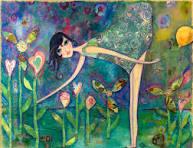
source: fineartamerica
efiant, curious gaze in her 2008 portrait “Forbidden Flowers.” The subject is an innocent-looking girl with enormous eyes, painted in a photorealistic style. She examines a bouquet of dark red flowers, which are believed to symbolize her burgeoning sexuality. This evocative juxtaposition between childhood and adulthood proved controversial, leading to censorship in the artist’s home country. When the painting was displayed in Kiev’s National Art Museum of Ukraine in 2009, it was promptly removed. Authorities deemed it inappropriate for the young museum visitors. Despite the backlash, “Forbidden Flowers” remains one of Telets’ most recognizable works.
Read Also: Top 15 T-Shirt Apparel Brands in Nigeria
2. The Tree of Knowledge 1 (eden) Painting
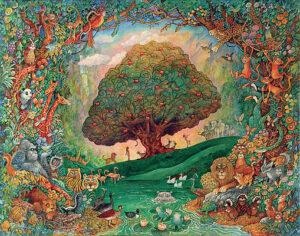
Taking inspiration from the Book of Genesis, Ecuadorian artist Guayasamín created his stark, allegorical work “The Tree of Knowledge” in 1959. Against a desolate brown background, a massive serpent coils around a dead tree. Its forked tongue points toward a plump green apple, alluding to the temptation of Eve. The minimal color palette and bereft environment convey a Biblical gravity. When Guayasamín displayed the painting at the Teatro Ecuador, the Catholic church sharply criticized its depiction of original sin. They believed his unflattering, skeletal serpent denigrated religious iconography. Despite controversy in its home country, “The Tree of Knowledge 1 (eden)” still garners critical acclaim for its thought-provoking interpretation of this iconic Bible story.
3. Eden Painting
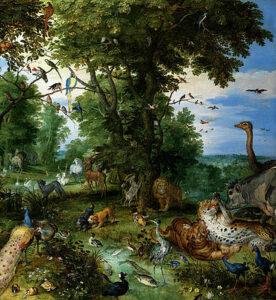
source: fineartamerica
The harmonious paradise envisioned in “Eden” by Paul Gauguin stirred controversy in France. Created in 1902, it centers on a Tahitian mother and child in a colorful, exotic jungle. Some art critics argued the painting’s nudity and sensuality were immoral, particularly as Tahiti was a French colony. The colonial government concurred, refusing to exhibit “Eden” at the 1903 Salon. However, Gauguin’s emphasis on natural beauty ultimately overshadowed any scandal. Today, museums display “Eden” as an important Post–Impressionist work fusing Gauguin’s Primitivist style with Biblical themes. Its verdant jungle landscape and symbolic mother and child also showcase his artistic imagination.
4. The Coming Storm Painting
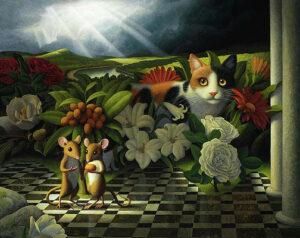
source: fineartamerica
With its dynamic clouds and foreboding sky, Albert Pinkham Ryder’s “The Coming Storm” visualizes both meteorological and societal unrest. Ryder finished this moody seascape in 1885, in the midst of labor disputes and financial volatility in America. Art historians believe the painting may reference a violent 1883 strike against the Northern Pacific Railroad. Critics at the Salon of 1885 found “The Coming Storm” too dark and sinister, rejecting it from their annual Paris exhibition. Yet Ryder’s ominous vision struck a chord with some. The painting marked a shift towards turbulent, psychological themes in his work. Over a century later, “The Coming Storm” is regarded as an influential precursor to Abstract Expressionism.
Read Also: 15 Simple Ways to Improve Your Health
5. Tree Of Knowledge 2 Painting

source: fineartamerica
Brazilian artist Carlos Merida put a modern spin on the Biblical Tree of Knowledge theme in his 1956 work of the same name. Adam and Eve are simplified into abstracted, geometric forms with elongated cylindrical bodies. The tree lacks natural detail, instead rendered as interconnected orbs and angular branches. Bold primary colors heighten the modernist appearance. When exhibited, the Catholic church denounced Merida’s avant-garde approach to religious subject matter. Modern art had no place depicting scriptural stories in their view. Nonetheless, “Tree of Knowledge 2” remains one of Merida’s defining examples of integrating Pre-Columbian and religious influences into his contemporary, Cubist-inspired aesthetic.
👉 Relocate to Canada Today!
Live, Study and Work in Canada. No Payment is Required! Hurry Now click here to Apply >> Immigrate to Canada6. The Garden of Earthly Delights, 1490-1510 Painting
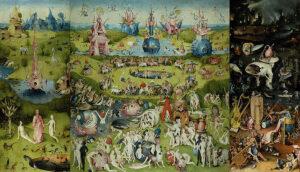
source: fineartamerica
Hieronymus Bosch’s triptych “The Garden of Earthly Delights” overflows with fantastical, often lurid details. When closed, the altarpiece depicts the Creation story in grisaille. But its chaotic central and rightmost panels visualize humanity’s pleasures and subsequent punishment. Throngs of nude figures gleefully frolic amongst oversized fruit and odd creatures. The panel on the right portrays a nightmarish, graphic hellscape. Bosch’s detailed originality mesmerized – but also disturbed – viewers. Soon after the work was created, the altarpiece was censored by its owners, the Counts of Nassau. The family had the entire central panel painted over to conceal its provocative imagery. Today, restored versions of Bosch’s masterpiece are celebrated for their imagination and unique insight into medieval concepts of sin.
7. In the Grotto Painting

source: fineartamerica
Théodore Chassériau’s 1852 painting “In the Grotto” faced backlash because of its portrayal of lesbian intimacy. It depicts two female nudes embracing in a lush tropical setting, overlooked by a statue of Venus. Critics denounced the sensual depiction of same-sex desire as immoral and unnatural. The controversy caused Chassériau to withdraw the painting from the Paris Salon exhibition that year. He even repainted it, changing the interaction between the women to be more ambiguous. But the original version remains Chassériau’s boldest representation of female intimacy. Unlike similarly themed works catering to male viewers, “In the Grotto” depicts queer desire from an authentic, less objectifying perspective.Information guide Nigeria
8. Adam in Paradise Painting
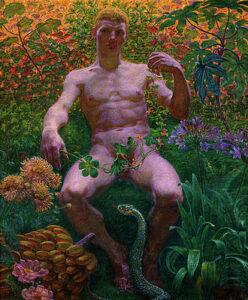
source: fineartamerica
Controversy arose from how American artist Thomas Cole depicted the first man in his 1828 painting “Adam in Paradise.” Unlike traditional Renaissance nudes, Cole’s life-size Adam appears fully nude rather than strategically covered. Displayed at the National Academy of Design, this unprecedented full frontal male nudity shocked viewers. Critics also denounced Cole’s realistic musculature as too lustful for a Biblical scene. The outrage escalated to an 1831 court case charging the painting’s exhibition as indecent. Though Cole was eventually acquitted, the experience led him to avoid similar themes. Today, scholars view “Adam in Paradise” as an important step in expanding accepted avenues for male nudes and naturalism in American art.
Read Also: Top 15 Environmental NGOs in Nigeria
9. Eve Within Painting
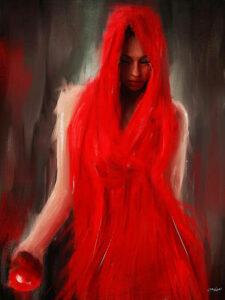
source: fineartamerica
The exposed full frontal female nudity of “Eve Within” sparked intense criticism in 19th century Britain. Painted in 1884 by Walter Langley, it shows Eve examining her own reflection as she contemplates eating the forbidden fruit. While nude studies of women already existed, the intimate self-observation in “Eve Within” pushed boundaries. Displayed at the Royal Academy of Arts, some deemed it indecent and unpleasant. Critics specifically attacked Langley’s uncompromising naturalism, unlike idealized classical nudes. After this backlash, the Royal Academy did not exhibit the painting again for decades. While provocative in its era, “Eve Within” endures as a triumph of Langley’s skill in capturing depth and human expression.Romantic love message
10. The Thorn Birds Painting
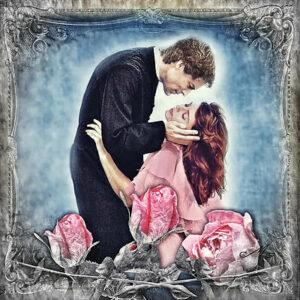
source: fineartamerica
Combining surrealist symbolism with eroticism, Dorothea Tanning’s “Eine Kleine Nachtmusik” became known as “The Thorn Birds” after its initial exhibition. The 1947 painting portrays nude prepubescent girls interacting with a plume of feathers sprouting from mysterious flowers. Critics denounced its sexualization of young girls as obscene and unsettling. Philadelphia police even seized the painting during Tanning’s 1948 show at the Wakefield Gallery. Her dismissal of conventional beauty standards also sparked outrage. But Tanning refused censorship, calling the painting a meditation on “innocence and corruption.” She fought successfully for its release. Today, “The Thorn Birds” is acclaimed for its dreamlike imagery pushing boundaries of female representation.Good morning My Love Message
11. Adam and Eve The Naked Truth Painting
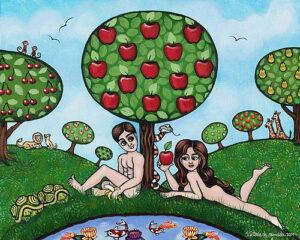
source: fineartamerica
When exhibited in Capetown’s Michaelis School of Fine Art, South African artist Willie Bester’s 1991 “Adam and Eve” painting stirred violent protest. The life-size nude portrait confronted apartheid through portraying an interracial couple as the Biblical Adam and Eve. Students and clergy decried the work as pornographic and blasphemous. Protestors vandalized and repeatedly slashed the canvas. South African authorities also leveled obscenity charges at the Michaelis School for displaying nudity publicly. However, museum staff defended the painting as an act of artistic freedom combatting apartheid values. “Adam and Eve” ultimately escaped permanent damage while spotlighting racist censorship.JAMB portal
12. Forbidden Books Painting
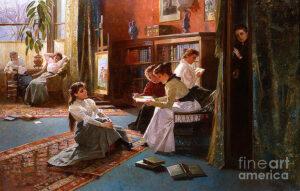
source: fineartamerica
Hammer Museum founder Armand Hammer purchased British artist Aubrey Beardsley’s “The Forbidden Books” in 1973, although the work itself dated back to 1896. The striking black and white illustration envisions a monk in his walled garden, surrounded by female nudes representing banned literature. Critics at the time deemed Beardsley’s eroticized personifications and phallic imagery sacrilegious. The Metropolitan Museum of Art even turned down an opportunity to acquire the work in 1909 due to its nudity. When the Hammer Museum exhibited “The Forbidden Books” in 1990, it remained controversial. Los Angeles Times art critic Christopher Knight called Beardsley’s mixture of eroticism and piety “lewd.” But the museum retained the work as an example of Beardsley’s 19th century publishing success.
Read Also: 15 Best Patterned Heels
13. The Forbidden Kiss Painting
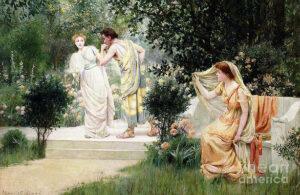
source: fineartamerica
Austrian Symbolist painter Gustav Klimt endured accusations of pornography after exhibiting “The Kiss” in 1908. Klimt departed from traditional depictions of romantic couples by shrouding his lovers in patterned gold robes. The composition also lacks intimacy, with their faces obscured and rigid bodies fused together. While lauded by the art elite, mainstream press deemed its erotic intimacy obscene and criticized its departure from realism. Outrage escalated with its 1912 exhibition in Budapest, where protestors threw stones at the work. Though provocative, “The Kiss” advanced Klimt’s reputation through its masterful gold leaf technique and ornate abstraction. The painting has since become one of art history’s most renowned representations of love.
14. In the Forbidden City in Beijing Painting
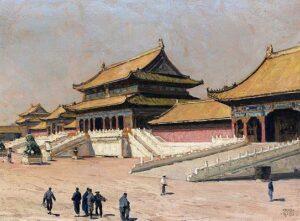
source: fineartamerica
British artist William Alexander’s depiction of Beijing’s historic Forbidden City elicited harsh condemnation from Qing dynasty authorities. Created during his 1793 diplomatic mission to China, the monumental painting provided early Western views of the secretive palace complex. Chinese officials objected to the perspective, which placed the viewer above the Emperor’s throne in a position of power over it. They deemed this distortion of imperial hierarchy offensive. Under diplomatic pressure, Alexander reluctantly changed the viewpoint to a distant vantage. Nevertheless, “In the Forbidden City in Beijing” preserved the complex’s architectural magnificence after centuries hidden from the Western eye. Today it offers invaluable visual insights into 18th-century China.
15. Forbidden Love – Erotica Painting
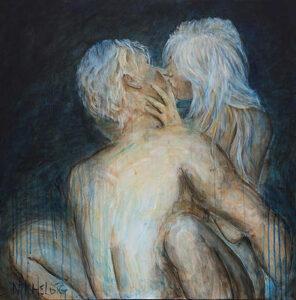
source: fineartamerica
When Polish artist Jarosław Kukowski unveiled his photorealistic painting “Forbidden Love” in 2009, its sexual explicitness generated protest. The provocative work shows a couple having rear-entry intercourse against a layer of banned books. Conservative politicians deemed the image pornographic and campaigned to remove it from Gdansk’s National Museum. However, the artist defended its commentary on censorship and religious repression of sexuality. He argued graphic representation makes the theme more impactful. Museum staff supported keeping the controversial painting, though providing warning labels about its content. Despite the backlash, “Forbidden Love” remain one of Kukowski’s most powerful surrealist expressions of eroticism.NYSC Portal
Read Also: 15 Most Trending Cruelty-Free Heels
Conclusion
What makes art taboo or forbidden has continually evolved across different societies. As evidenced by these 15 paintings, controversy often emerges when art challenges ingrained cultural or religious conventions. Elements like nudity, sexuality, and anti-authoritarian themes have repeatedly sparked censorship.
Yet over time, scandals fade and public opinion shifts. Works once deemed obscene become appreciated as masterpieces. While debate continues over many provocative paintings, examining the stories behind them provides illuminating insights into our social history. Their lasting impact is undeniable.
These forbidden paintings illustrate art’s immense power to viscerally impact audiences and violate norms. By documenting fascinating moments of defiance, they offer a revealing look at the boundaries of creative expression.
Check JAMB RESULT
Check and Confirm: How much is Dollar to Naira
